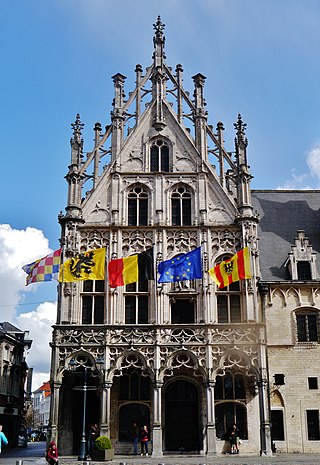ISO 3166 is a standard published by the International Organization for Standardization (ISO) that defines codes for the names of countries, dependent territories, special areas of geographical interest, and their principal subdivisions. The official name of the standard is Codes for the representation of names of countries and their subdivisions.

A national flag is a flag that represents and symbolizes a given nation. It is flown by the government of that nation, but can also be flown by its citizens. A national flag is typically designed with specific meanings for its colours and symbols, which may also be used separately from the flag as a symbol of the nation. The design of a national flag is sometimes altered after the occurrence of important historical events. The burning or destruction of a national flag is a greatly symbolic act.
Administrative divisions are geographical areas into which a particular independent sovereign state is divided. Such a unit usually has an administrative authority with the power to take administrative or policy decisions for its area.

Independence is a condition of a nation, country, or state, in which residents and population, or some portion thereof, exercise self-government, and usually sovereignty, over its territory. The opposite of independence is the status of a dependent territory or colony. The commemoration of the independence day of a country or nation celebrates when a country is free from all forms of colonialism; free to build a country or nation without any interference from other nations.

This is a collection of lists of flags, including the flags of states or territories, groups or movements and individual people. There are also lists of historical flags and military flag galleries. Many of the flag images are on Wikimedia Commons.

The provinces of Sweden are historical, geographical and cultural regions. Sweden has 25 provinces; they have no administrative function but remain historical legacies and a means of cultural identification pertaining to dialects and folklore.
A dependent territory, dependent area, or dependency is a territory that does not possess full political independence or sovereignty as a sovereign state and remains politically outside the controlling state's integral area. As such, a dependent territory includes a range of non-integrated not fully to non-independent territory types, from associated states to non-self-governing territories.

Madagascar was once divided into six autonomous provinces :
- Antananarivo Province
- Antsiranana Province
- Fianarantsoa Province
- Mahajanga Province
- Toamasina Province
- Toliara Province
This armorial of sovereign states shows the coat of arms, national emblem, or seal for every sovereign state. Although some countries do not have an official national emblem, unofficial emblems which are de facto used as national emblems are also shown below.
A state government is the government that controls a subdivision of a country in a federal form of government, which shares political power with the federal or national government. A state government may have some level of political autonomy, or be subject to the direct control of the federal government. This relationship may be defined by a constitution.
A central government is the government that is a controlling power over a unitary state. Another distinct but sovereign political entity is a federal government, which may have distinct powers at various levels of government, authorized or delegated to it by the federation and mutually agreed upon by each of the federated states.

In vexillology, a state flag is either the flag of the government of a sovereign state, or the flag of an individual federated state.
This is a list of the national coats of arms or equivalent emblems used by countries and dependent territories in Europe.
A province is an administrative division within a country or state. The term derives from the ancient Roman provincia, which was the major territorial and administrative unit of the Roman Empire's territorial possessions outside Italy. The term province has since been adopted by many countries. In some countries with no actual provinces, "the provinces" is a metaphorical term meaning "outside the capital city".
This gallery shows the coat of arms of each of the Dependent territories in the list of countries.
The decolonisation of Oceania occurred after World War II when nations in Oceania achieved independence by transitioning from European colonial rule to full independence.

This article is a gallery of the flags of the principal subdivisions of the countries and territories of Oceania. For purposes of this article, Oceania is taken to comprise Australasia, Melanesia, Micronesia and Polynesia.

The list of city flags lists the flags of cities. Most of the city flags are based on the coat of arms or emblems of its city itself, and city flags can be also used by the coat of arms and emblems on its flag. Most of the city flags are flown outside town halls and councils.
This page is based on this
Wikipedia article Text is available under the
CC BY-SA 4.0 license; additional terms may apply.
Images, videos and audio are available under their respective licenses.



































